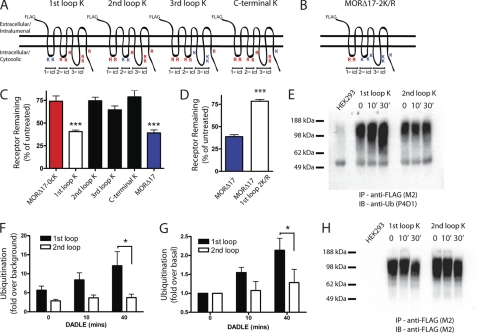FIGURE 5.
Ubiquitination specifically of the first cytoplasmic loop is necessary and sufficient for agonist-induced down-regulation measured by radioligand binding. A, shown is a diagram of the series of receptor mutants used to test sufficiency, based on reverting arginine residues to lysine residues within individual cytoplasmic domains of the F-MORΔ17–0cK backbone separately. The positions of lysine (K) or arginine (R) residues in each construct are indicated. B, shown is a diagram of the receptor mutant used to test necessity, based on mutating only the lysine residues present in the first cytoplasmic loop (1st icl) of F-MORΔ17 to arginine, as indicated. C, shown is down-regulation of the receptor constructs diagrammed in panel A, assayed by [3H]DPN binding after incubation of stably transfected cells expressing the indicated receptor construct with 10 μm DADLE for 5 h. In each experiment down-regulation was assessed in triplicate determinations. Bars represent the mean, and error bars are from n = 7 independent experiments (**, p < 0.01; ***, p < 0.001, one way ANOVA, Bonferroni post test). D, shown is down-regulation of the receptor construct diagrammed in panel B. E, shown is a representative anti-ubiquitin immunoblot (IB) used for the densitometry analysis summarized in panels F and G. IP, immunoprecipitate. F and G, shown is quantification of relative ubiquitin incorporation from densitometry of anti-ubiquitin blots expressed as -fold over basal measured in unstimulated cells (panel G) or -fold over background measured in cells not expressing FLAG-tagged receptor (panel F). Bars represent mean and S.E.; error bars, n = 4; * denotes p < 0.05 as determined by two-way ANOVA with the Bonferroni post-test). H, the same blot is shown in panel E except it was stripped and reprobed with anti-FLAG, to verify comparable receptor loading between lanes.

